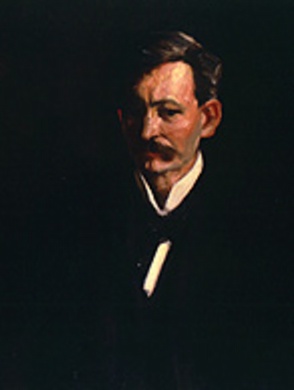Robert Henri
Self-Portrait
During my first two years at The Chase School, Frank V. Dumond, Luis Mora, and Kenneth Hayes Miller were the instructors. All were good teachers; each one had his own following among the students. Mora was especially popular, and I remember well the clever drawings he made to illustrate his criticisms. Then, in 1902, my third year, Frank Dumond left and Robert Henri came to take Dumond's place as a teacher.
Almost from the first moment, Henri became the dominant influence in the school. With a few exceptions, he was to all of his students the unquestioned Master. His teaching seemed (and was) revolutionary at the time. He had no use for "official" art. He urged us to study life around us and to express our own ideas. He said, "Art should first of all communicate." We hung on his every word.
On criticism days, Henri would line up the drawings against the wall and open a general discussion of them. He would point to a good feature here, bad one there. Over and over again he would say that he cared nothing for the technical proficiency we had been taught by former instructors. To those of us who were technically clever, this was baffling and occasionally galling for he often praised awkward drawings of beginners and remained silent while staring at the work of good craftsmen. The idea and the emotion were all-important, the manner of conveying them negligible. This is a commonplace idea today; sixty years ago it was revolutionary. We finally adopted his point of view as our own.
Henri's talks were always stimulating, often philosophical, and ranged widely beyond the craft of painting. He liked Walt Whitman enormously. Of the painters, Manet was a great favorite - especially the Woman with Parrot in the Met, and the Boy with Sword. He also talked at length about Glackens and Sloan, his great friends. (This was the birthplace of the Ashcan School.) We all thought "The Eight" were absolutely tops and rushed to see everything they painted.
We also rushed to see Henri's work. I remember admiring particularly a portrait, Young Woman in Black, exhibited at the National Academy. We all thought it a great painting and went to see it many times. It is a very sensitively painted head, one of his best. Something like Whistler.
Aside from our nearer contemporaries among "The Eight," Whistler and Sargent were probably the most talked-of painters by the students. They admired the subtle harmonies of Whister and the flashing technique of Sargent. We adminred Henri's technique, the slashing stroke, too. Despite his emphasis on idea over technique, I think he himself actually thought too much about technique. He believed that no two subjects required the same treatment, so he varied his style consciously with the subject. As a result, some of his things are superficial, certainly lacking in substance and structure; some show a trace of artificiality, of theatricality. On the other hand, many of them look like sketches - good starts. But, at the same time, we were dazzled by their "dash." (It is interesting that with totally different philosophies, both Chase and Henri were beguiled by their virtuosity into flawing many otherwise fine works.)
Henri was unusually kind and sympathetic to his students. He urged them exhibit and often helped them to do so. I remember one member of the class who was never entirely won over by Henri, who had criticized him rather severely, pleading with him to break loose from his academic style. Then, one day, this student produced something really good. Henri was ecstatic. He took the painting to his studio, framed it, and sent it to the Academy where it was accepted and much admired.
I wanted some photographs of Henri's work and asked him about it. After I had obtained them from the photographer, Henri bought me some little gold frames for them. When I went to Vassar College in 1915 as Artist-in- Residence, most of my friends said, "That's the end of Chatterton as a painter." A few years later, many of them were looking for similar positions. Henri was genuinely interested in me going to Vassar and wrote a glowing letter of recommendation for me. And, when I was at the college and in charge of exhibitions, he furnished me with several works, carefully selected, to be hung, as he specified, "by you alone."
Eugene Speicher told me that when Henri was desperately ill in the hospital, shortly before he died, he was miserable that he could not see the show Speicher was about to have at the Rehn Gallery. So, on a Saturday, the day before the exhibition was to open, Speicher and Rehn took all the paintings to Henri's bedside at the hospital. In spite of his greatly weakened consition, he excitedly commented about every painting.
Henri's interest in George Bellows was, and is, known by everyone. They were great and close friends. At a dinner given for Henri at the Salmagundi Club, Bellows said that he owed everything he had achieved as an artist to his teacher and friend.
Perhaps Henri gave too much encouragement to beginners. Without real competence or understanding, I think it can be harmful. But, for students with solid training in drawing and painting, he was great. In many cases he pushed them over the line from mediocrity to original creativity by showing them how to utilize their technical equipment to say something worthwhile as artists. In spite of his insistence on artistic freedom, he constantly urged visual honesty and had no use for personal idiosyncrasies. "A growing tree," he would say, "is as wonderful today as it ever was. It doesn't need to try out new and startling methods." Most of us considered him a great teacher and a profound influence. Even in retrospect, it seems to me that Henri was the greatest teacher of painting that America has had.
Chatterton's recollection is continued here.
